Pcl3 Study guides, Class notes & Summaries
Looking for the best study guides, study notes and summaries about Pcl3? On this page you'll find 82 study documents about Pcl3.
All 82 results
Sort by
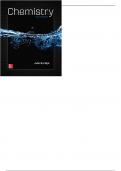 Popular
Popular
-
Test Bank For Chemistry 4th Edition by Julia Burdge
- Exam (elaborations) • 809 pages • 2023
-
- $32.13
- 1x sold
- + learn more
Chapter 03 Stoichiometry: Ratios of Combination 1. Calculate the molecular mass of tetraphosphorus decaoxide, P4O10, a corrosive substance which can be used as a drying agent. A. 469.73 amu B. 283.88 amu C. 190.97 amu D. 139.88 amu E. 94.97 amu 2. Calculate the formula mass of rubidium carbonate, Rb2CO3. A. 340.43 amu B. 255.00 amu C. 230.95 amu D. 145.47 amu E. 113.48 amu 3. Calculate the formula mass of (NH4)3AsO4. A. 417.80 amu B. 193.05 amu C. 165.02 amu D. 156.96 amu E. 108.96 a...
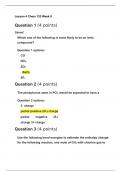
-
CHEM133 Week 9 Lesson 4 Quiz
- Exam (elaborations) • 12 pages • 2023
- Available in package deal
-
- $29.99
- + learn more
1. Question: Which one of the following is most likely to be an ionic compound? 2. Question: The phosphorus atom in PCl3 would be expected to have a 3. Question: The phosphorus atom in PCl3 would be expected to have a give CH3Cl and hydrogen chloride. 4. Question: How many of the following molecules have no dipole moment? 5. Question: Atoms having equal or nearly equal electronegativities are expected to form 6. Question: Element A has an electronegativity of 0.8 and element B has an electr...
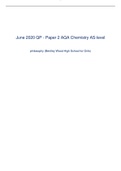
-
AQA June 2020 QP - Paper 2 AQA Chemistry AS-level
- Exam (elaborations) • 33 pages • 2023
- Available in package deal
-
- $15.99
- + learn more
AQA June 2020 QP - Paper 2 AQA Chemistry AS-level AQA June 2020 QP - Paper 2 AQA Chemistry AS-level The equation for a reaction used to manufacture 1-chloropropane is 3CH3CH2CH2OH(l) + PCl3(l) → 3CH3CH2CH2Cl(l) + H3PO3(s) The enthalpy change for this reaction, ΔH, is –114 kJ mol–1 Table 1 contains some standard enthalpy of formation data
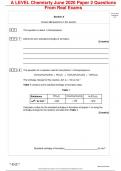
-
A LEVEL Chemisrty June 2020 Paper 2 Questions From Real Exams
- Exam (elaborations) • 31 pages • 2023
-
- $13.49
- + learn more
A LEVEL Chemisrty June 2020 Paper 2 Questions From Real Exams 1 2 Section A Answer all questions in this section. Do not write outside the box This question is about 1-chloropropane. . Define the term standard enthalpy of formation. [2 marks] . The equation for a reaction used to manufacture 1-chloropropane is 3CH3CH2CH2OH(l) + PCl3(l) 3CH3CH2CH2Cl(l) + H3PO3(s) The enthalpy change for this reaction, ΔH, is –114 kJ mol–1 Table 1 contains some standard enthalpy of formati...
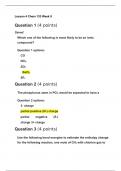
-
CHEM133 Week 9 Lesson 4 Quiz (All Correct)
- Exam (elaborations) • 12 pages • 2023
- Available in package deal
-
- $25.48
- + learn more
1. Question: Which one of the following is most likely to be an ionic compound? 2. Question: The phosphorus atom in PCl3 would be expected to have a 3. Question: The phosphorus atom in PCl3 would be expected to have a give CH3Cl and hydrogen chloride. 4. Question: How many of the following molecules have no dipole moment? 5. Question: Atoms having equal or nearly equal electronegativities are expected to form 6. Question: Element A has an electronegativity of 0.8 and element B has an electr...
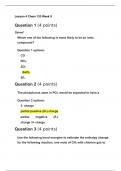
-
CHEM133 Week 9 Lesson 4 Quiz Questions and Answers APU
- Exam (elaborations) • 12 pages • 2023
- Available in package deal
-
- $23.99
- + learn more
1. Question: Which one of the following is most likely to be an ionic compound? 2. Question: The phosphorus atom in PCl3 would be expected to have a 3. Question: The phosphorus atom in PCl3 would be expected to have a give CH3Cl and hydrogen chloride. 4. Question: How many of the following molecules have no dipole moment? 5. Question: Atoms having equal or nearly equal electronegativities are expected to form 6. Question: Element A has an electronegativity of 0.8 and element B has an electr...
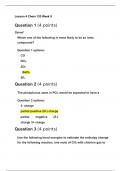
-
CHEM133 Week 9 Lesson 4 Quiz
- Exam (elaborations) • 12 pages • 2023
- Available in package deal
-
- $32.13
- + learn more
1. Question: Which one of the following is most likely to be an ionic compound? 2. Question: The phosphorus atom in PCl3 would be expected to have a 3. Question: The phosphorus atom in PCl3 would be expected to have a give CH3Cl and hydrogen chloride. 4. Question: How many of the following molecules have no dipole moment? 5. Question: Atoms having equal or nearly equal electronegativities are expected to form 6. Question: Element A has an electronegativity of 0.8 and element B has an electr...

-
CHEM133 Week 9 Lesson 4 Quiz
- Exam (elaborations) • 12 pages • 2023
-
- $32.49
- + learn more
1. Question: Which one of the following is most likely to be an ionic compound? 2. Question: The phosphorus atom in PCl3 would be expected to have a 3. Question: The phosphorus atom in PCl3 would be expected to have a give CH3Cl and hydrogen chloride. 4. Question: How many of the following molecules have no dipole moment? 5. Question: Atoms having equal or nearly equal electronegativities are expected to form 6. Question: Element A has an electronegativity of 0.8 and element B has an electr...

-
CHEM133 Week 9 Lesson 4 Quiz
- Exam (elaborations) • 12 pages • 2023
-
- $21.49
- + learn more
1. Question: Which one of the following is most likely to be an ionic compound? 2. Question: The phosphorus atom in PCl3 would be expected to have a 3. Question: The phosphorus atom in PCl3 would be expected to have a give CH3Cl and hydrogen chloride. 4. Question: How many of the following molecules have no dipole moment? 5. Question: Atoms having equal or nearly equal electronegativities are expected to form 6. Question: Element A has an electronegativity of 0.8 and element B has an electr...

-
UNE Chem 1011 week 5-7 review Questions With Complete Solutions
- Exam (elaborations) • 5 pages • 2023
- Available in package deal
-
- $10.49
- + learn more
For the reaction F2(g) ⇌ 2 F(g), the equilibrium constant at 223 °C is 7.3 x 10-13. If a sample of F2 is heated to 223 °C and allowed to reach equilibrium correct answer: nearly all of F2 will remain unreacted, with a very small amount of F present At equilibrium correct answer: the rate of the forward reaction is equal to the rate of the reverse reaction and the concentration of the reactants and products can be very different For the reaction 2 BrCl(g) ⇌ Br2(g) + Cl2(g), the equi...

Did you know that on average a seller on Stuvia earns $82 per month selling study resources? Hmm, hint, hint. Discover all about earning on Stuvia


